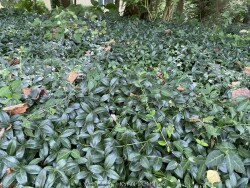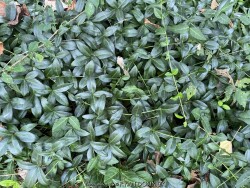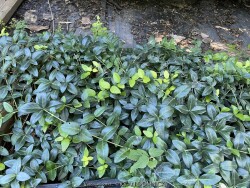



Plant Min Zone: 4a
Plant Max Zone: 8b
Sunlight: Part Sun, Shade, Deep Shade
Water / Rainfall: Low, Average
Soil Quality: Poor, Average
Bloom Season: Spring, Early Summer
Flower Color: Blue
Berry / Fruit Color: None
Spring Foliage Color: Dark Green
Summer Foliage Color: Dark Green
Fall Foliage Color: Dark Green
Evergreen Foliage: Yes
Winter Interest: Yes
Scented Flowers: No
Drought Tolerance: Medium, High
Wet-Feet Tolerance: Low
Humidity Tolerance: Low, Medium
Wind Tolerance: Medium
Poor Soil Tolerance: Clay Soils, Rocky Soils, Alkaline Soils (high PH)
Height: 0.25' - 0.5'
Width: 1' - 2'
Growth Rate: Slow
Service Life: Long: 5-10 years
Maintenance Need: Medium
Spreading Potential: Medium
Yearly Trimming Tips: Trim Evergreen Perennial Only if Winter-Kill Occurs.
Plant Grouping Size: Medium Grouping of 5-10, Mass Planting of 10 or more
Best Side of House: East Exposure, North Exposure
Extreme Planting Locations: None
Ornamental Features: Emerges Early in Spring, Multiple Seasons of Interest
Special Landscape Uses: Groundcover
Possible Pest Problems: Weed Competition, Foliage Disease, Stem/Crown Disease
Plant Limitations: Slow to Reach Mature Size, Overused in the Landscape, Environmental Stress / Decline, May be Poisonous
Shippable in 2026: YES
Vinca Minor / Periwinkle is an evergreen groundcover native to central and southern Europe but naturalized and has become invasive in parts of North America. The evergreen leaves are a glossy dark green with a leathery texture. The 5-petal violet-purple flowers are produced mainly from early spring to mid summer but with a few flowers still produced into the autumn. Landscape uses include small scale groundcovers and hillside areas in full to part shade. In full sun, foliage burn occurs in late summer and with slow recovery, weeds find an opportunity to invade. Due to slow spreading growth in our Kansas climate, you shouldn't leave very much room in-between vinca plants or you will be waiting many years for the patch to fill in. Weeds can again be a problem in that open area between plants if spacing is too wide. We recommend 9-12" spacing and use for small nooks in the shade garden. If planning for a larger area, still figure on the tight spacing but allow for a higher budget that you will consider a permanent investment. However, a serious vine stem canker (blight / disease), limits its use in our area and can damage or kill large patches. Good air circulation and limiting night-time irrigation can reduce the prevalence of this disease. Generally this plant declines after a few years of Kansas climate but worth a try in perfect soils in well-tended shade gardens. The canker disease and competition with weeds seem to be an issue. Roundup effectively eraticates patchy leftover remnant growth after disease runs its course when clearing the area for better groundcover species.